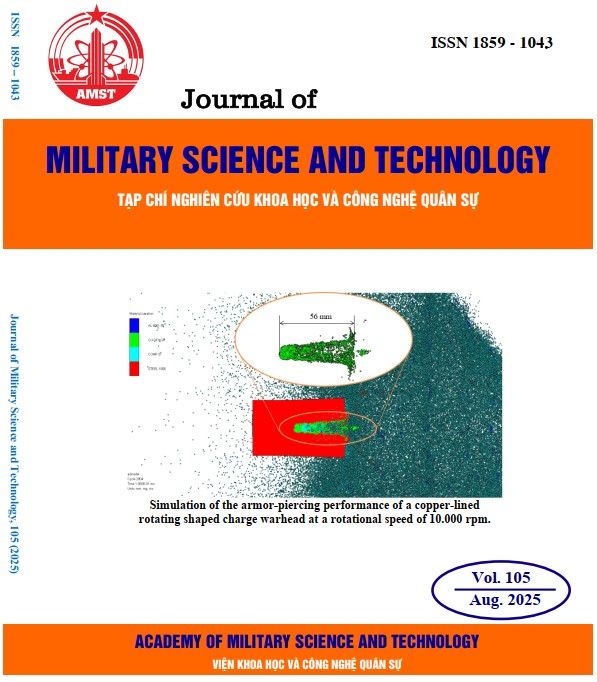Research on the manufacturing of Fe2O3/TiO2-based adsorbent granules for application in treating Pb²⁺-contaminated water
280 viewsDOI:
https://doi.org/10.54939/1859-1043.j.mst.105.2025.83-89Keywords:
Adsorbent granulation; Fe2O3/TiO2 composite; Heavy metals; Pb2 ; Column adsorption.Abstract
In this paper, Fe2O3/TiO2 adsorbent granules were fabricated via a drum-type granulation method with bentonite as a binder. The granulation process included three steps: mixing Fe2O3/TiO2 mixture of powder and fine coal dust into a homogeneous mixture, granulating by spraying water mist, drying the beads, and calcining at 500 oC for 1 h to form pores. The characteristic structures of composite materials after fabrication are evaluated by various methods, such as X-ray diffraction and scanning electron microscopy with energy dispersive X-ray spectroscopy. The performance evaluation of the fabricated adsorbent granulation for removing Pb2+ from polluted water was studied using a fixed-bed adsorption column. The factors affecting the adsorption performance, such as height of the adsorption column, flow rate, and inlet Pb2+ concentration, were determined. In column mode, the longest exit time was 450 minutes, the saturation time was 723 minutes, and the adsorption efficiency was 78.202% at the initial concentration of 5 mg/l, column height of 16 cm, and flow rate of 5 ml/min. The adsorption data with three well-established fixed-bed adsorption models, namely the Adam-Bohart, Thomas, and Yoon-Nelson models, with a correlation coefficient, R2 > 0.95.
References
[1]. Z. Fu et al., “The Effects of Heavy Metals on Human Metabolism”, Toxicology Mechanisms and Methods, Vol. 30, No 3, pp. 167-176, (2020). DOI: https://doi.org/10.1080/15376516.2019.1701594
[2]. K. Renu et al., “Molecular mechanism of heavy metals (Lead, Chromium, Arsenic, Mercury, Nickel and Cadmium) - induced hepatotoxicity - A review”, Chemosphere, Vol. 271, 129735, (2021). DOI: https://doi.org/10.1016/j.chemosphere.2021.129735
[3]. I. R. Chowdhury et al., “Removal of lead ions (Pb2+) from water and wastewater: a review on the low-cost adsorbents”, Applied Water Science, Vol. 12, No. 185, (2022). DOI: https://doi.org/10.1007/s13201-022-01703-6
[4]. Y.B. Nthwane et al., “A comprehensive review of heavy metals (Pb2+, Cd2+, Ni2+) removal from wastewater using low-cost adsorbents and possible revalorisation of spent adsorbents in blood fingerprint application”, Environ Technol, Vol 46, No.3, pp. 414-430, (2025). DOI: https://doi.org/10.1080/09593330.2024.2358450
[5]. V. U. Siddiqui et al., “Alginate-based materials as adsorbent for sustainable water treatment”, International Journal of Biological Macromolecules, Vol 298, 139946, (2025). DOI: https://doi.org/10.1016/j.ijbiomac.2025.139946
[6]. J.C. Bullen et al., “Improved accuracy in multicomponent surface complexation models using surface-sensitive analytical techniques: Adsorption of arsenic onto a TiO2/Fe2O3 multifunctional sorbent”, Journal of Colloid Interface Science, Vol. 580, pp. 834-849, (2020). DOI: https://doi.org/10.1016/j.jcis.2020.06.119
[7]. A. Mendis et al, “Fabrication of Naturally Derived Chitosan and Ilmenite Sand-Based TiO2/Fe2O3/Fe-N-Doped Graphitic Carbon Composite for Photocatalytic Degradation of Methylene Blue under Sunlight”, Molecules, Vol. 28, No. 7, 3154, (2023). DOI: https://doi.org/10.3390/molecules28073154
[8]. C.V.Tran et al. “Facile Fabrication of Fe2O3/TiO2 Composite from Titanium Slag as Adsorbent for As(V) Removal from Aqueous Media”, Sustainability, Vol. 15, No. 9, 7253, (2023). DOI: https://doi.org/10.3390/su15097253
[9]. R. Bergamasco et al., “Adsorption of Atrazine from Synthetic Contaminated Water Using a Packed-Bed Column with a Low-Cost Adsorbent (Moringa oleifera Lam.)”, Water, Vol. 15, No. 7, 1260, (2023). DOI: https://doi.org/10.3390/w15071260
[10]. O.B. Omitola et al., “Adams-Bohart, Yoon-Nelson, and Thomas modeling of the fix-bed continuous column adsorption of amoxicillin onto silver nanoparticle-maize leaf composite”. Applied Water Science, Vol. 12, No. 5, pp. 94, (2022). DOI: https://doi.org/10.1007/s13201-022-01624-4







